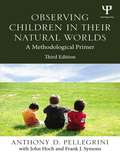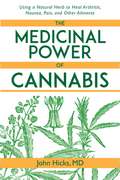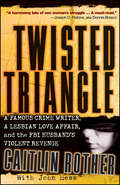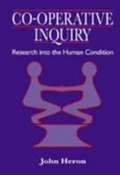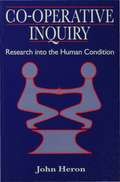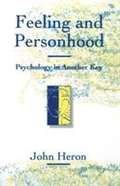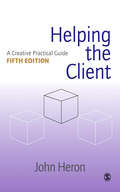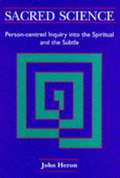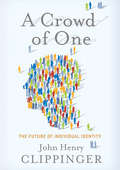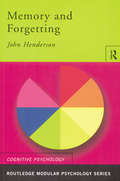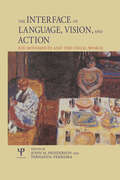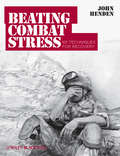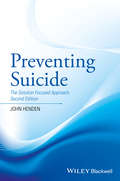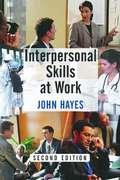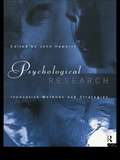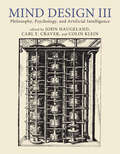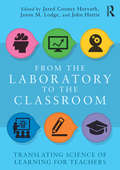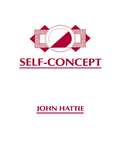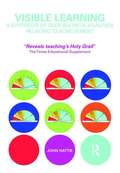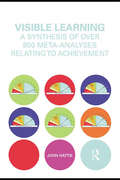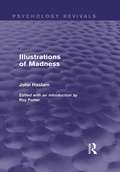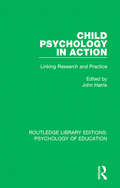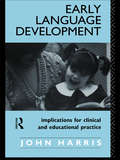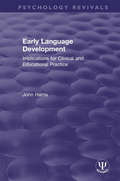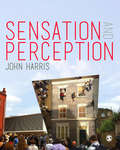- Table View
- List View
Observing Children in Their Natural Worlds: A Methodological Primer, Third Edition
by Anthony D. Pellegrini Frank Symons John HochThis book shows readers how to conduct observational methods, research tools used to describe and explain behaviors as they unfold in everyday settings. The book now uses both an evolutionary and a cultural perspective. The methods presented are drawn from psychology, education, family studies, sociology, and anthropology, but the author's primary focus is on children in school, family, and social settings. Readers learn how to make observations in real contexts to help them create a verbal picture of behaviors they see. The importance of considering reliability and validity factors while testing within each environment is emphasized throughout. The author draws from the literature that provides methods for observing animals in their natural habitats, but emphasizes the use of observational methods to solve human problems. The book is organized in the way a researcher conducts observational studies—conceptualizing of the idea, designing and implementing the study, and writing the report. “Things to think about” sections provide an opportunity for students to solidify their understanding of the material and the Glossary defines the key terms introduced in the book. Highlights of changes in the new edition include: • The introduction of the cultural perspective in chapter 4 along with the evolutionary (epigenetic theory) perspective and the integration of cultural examples throughout the book. • More varied examples from developmental psychology, family studies, and education.• Extensively revised chapter (3) on ethics reflects the current revelations of scientific fraud and the push for researchers to maximize scientific integrity in their community. • Updated chapter (12) reflects the latest computer technologies used in observational methods including iPhones and Blackberrys for conducting observation, ABC Data Pro and Behavior Tracker for evaluations, and Excel for constructing observational templates. • Expanded chapter (13) on writing the research report and more on issues of plagiarism (ch. 3). • The latest on minimizing observer effects on participants and testing their effectiveness.• New environmentally friendly design, the Things to Think About sections were retained, but the blank pages for answers were eliminated. Intended as a supplementary text for advanced undergraduate and/or graduate courses in research methods and/or developmental research or developmental/child psychology taught in psychology, education, human development, and nursing, educators and researchers concerned with assessing children will also appreciate this book’s introduction to observational methods.
Medicinal Power of Cannabis: Using a Natural Herb to Heal Arthritis, Nausea, Pain, and Other Ailments
by John HicksIt's no surprise that marijuana has healing powers, but whether or not using it to treat common ailments should be legalized continues to be a hot topic of debate among government leaders and medical practitioners alike. Marijuana comes from the cannabis plant, an herb whose leaves can be extracted and used as a recreational drug, allowing users to feel a euphoric high. But the cannabis plant has many non-psychoactive properties as well. Cannabidiol, also known as CBD is a substance extracted from the cannabis plant that has been proven to have all the healing powers of marijuana without the psychoactive properties. With over thirty years of experience in integrated holistic health, Dr. John Hicks presents here his extensive knowledge and research. In this revolutionary book, Dr. Hicks touches on an area of holistic health that many medical practitioners have over looked in the past. He begins by explaining the root cause of most diseases--inflammation--and then illustrates how inflammation progresses into the various diseases and ailments that plague us. Finally, he shows how CBD can stop the inflammation and heal the problem. CBD has been shown to help: Anxiety Alzheimer's disease Seizures Huntington's disease Nausea and vomiting And much, much more With information ranging from easy-to-understand terminology to scientific studies based on Hick’s decades of experience in integrative medicine, this book has a little bit of something for everyone, from your typical hypochondriac to the seasoned medical practitioner.
Twisted Triangle
by Caitlin Rother John HessPraise for Twisted Triangle"This book will haunt you. It will move you to look at some of the harsh realities of life in a new way. A powerful story-and masterfully written."-Aphrodite Jonesbest-selling author, All She Wanted and Cruel Sacrifice"A harrowing tale of one woman's struggle to maintain a balance between being a mother, an FBI agent, and dealing with a corrupt husband also an FBI agent. A must-read."-Joseph D. Pistoneaka Donnie Brasco"Hitchcock wishes he'd dreamed it up. Capote wishes he'd written it. Rother's mesmerizing narrative chronicles a wife's heroic struggle against great odds to survive her psychopathic husband's elaborate scheme to make her murder the perfect crime. This spellbinding tale offers an added treat-it's true."-Marcus SternPulitzer Prize-winning journalist and author, The Wrong Stuff: The Extraordinary Saga of Randy "Duke" Cunningham, the Most Corrupt Congressman Ever Caught"This in-depth account brought back memories of a most bizarre case, proving once again that the truth can be stranger than fiction."-Paul B. EbertCommonwealth's attorney, County of Prince William, Virginia
Co-operative Inquiry: Research Into The Human Condition
by John HeronThis is the first book to provide a comprehensive account of co-operative inquiry: a way of doing research with people where the roles of researcher and subject are integrated. Co-operative inquiry is a distinctive and wide-ranging form of participative research in which people use the full range of their sensibilities to inquire together into any aspect of the human condition. This book offers both an extensive exploration of its theoretical background and a detailed practical guide to the methods involved. Topics covered include: a critique of established research techniques; the underlying participative paradigm of co-operative inquiry; the epistemological and political aspects of participation; different types of co-operative inquiry and the range of inquiry topics; ways of setting up inquiry groups and enabling their development; four kinds of inquiry outcome and the primacy of the practical; the main stages of the inquiry cycle, highlighting key issues for practice at each stage; and special skills and procedures used for enhancing validity.
Co-operative Inquiry: Research into the Human Condition
by John HeronThis is the first book to provide a comprehensive account of co-operative inquiry: a way of doing research "with" people where the roles of researcher and subject are integrated. Co-operative inquiry is a distinctive and wide-ranging form of participative research in which people use the full range of their sensibilities to inquire together into any aspect of the human condition. This book offers both an extensive exploration of its theoretical background and a detailed practical guide to the methods involved. Topics covered include: a critique of established research techniques; the underlying participative paradigm of co-operative inquiry; the epistemological and political aspects of participation; different types of co-operative inquiry and the range of inquiry topics; ways of setting up inquiry groups and enabling their development; four kinds of inquiry outcome and the primacy of the practical; the main stages of the inquiry cycle, highlighting key issues for practice at each stage; and special skills and procedures used for enhancing validity.
Feeling and Personhood: Psychology in Another Key
by John HeronJohn Heron presents a radical new theory of the person in which feeling, differentiated from emotion, becomes the distinctive feature of personhood. The author explores the applications of his ideas to living and learning and the text includes numerous experiential exercises. Heron considers how the person develops through various states and stages and contrasts the restricted ego with integrated personhood. Central to his analysis are interrelationships between four basic psychological modes - affective, imaginal, conceptual and practical. In particular, feeling is seen as the ground and potential from which all other aspects of the psyche emerge - emotion, intuition, imaging of all kinds, reason, discrimination, intention and action. Heron also shows the fundamental relation of his ideas to theory and practice in transpersonal psychology and philosophy. In the last part of the book, the author examines the implications of his theory for understanding and enhancing both formal and life learning. Feeling and Personhood will be essential reading for psychologists, educationalists, counsellors, psychotherapists and all those who believe it is time for a challenging alternative to traditional reason-centred and ego-bound psychology.
Helping the Client: A Creative Practical Guide
by John Heron`Those who claim to have counselling among their skills should read this book and reflect on their own practice. This would in itself be a growth experience for many' - British Journal of Psychiatry `The author rewards one with a wealth of interventions which are, as the subtitle suggests, very creative but also very practical' - Nursing Times Helping the Client is the bestselling text which has long been used as the basis of interpersonal skills training in a wide range of professions from medicine to management. Based on John Heron's well-known six category model, the book presents different forms of helping behaviour which can be adopted by any practitioner working face-to-face with a client. Drawing on his many years of experience as a therapist, consultant and teacher, the author explores the contexts and issues associated with these different forms of helping and, for each, describes a wide range of practical interventions for the practitioner to use. He examines the objectives of helping, states of personhood, the many ways in which helping can degenerate, the preparation and training of the practitioner, and examples of how the interventions can be used by different occupational groups. Helping the Client is the Fifth Edition of the book originally entitled Six Category Intervention Analysis. Revised and enlarged throughout, with a new chapter on co-working, the book remains essential reading for the development of interpersonal skills, in counselling, management, health care, social work, youth and community work, education, and many other professions.
Sacred Science: Person-Centred Inquiry into the Spiritual and the Subtle
by John HeronThis book breaks new ground in transpersonal pscyhology. It argues for a people-based, person-centred religion which hold that spiritual authority is wihtin each individual, and that spiritual initiation is a path of lived inquiry, for which all traditional systems are a secondary resource. Sacred Science will be of interest to all those who believe in the emergence of the self-determining human spirit within the field of religious belief and practice. It is written for the general reader, yet specialists in transpersonal studies will find that it addresses critical issues at a sophisticated level.
A Crowd of One: The Future of Inidvidual Identity
by John HenryGreat leaps forward in scientific understanding have, throughout history, engendered similar leaps forward in how we understand ourselves. Now, the new hybrid disciplines of evolutionary biology and social physics are making the next leap possible-and fundamentally altering our notions of individual identity. If identity is a fact not derived from within the individual, but conferred on an individual by a group, or network, a host of assumptions about how governments work, how conflicts arise and are resolved, and how societies can be coaxed toward good are overturned. John Clippinger brilliantly illuminates how the Enlightenment itself-the high point of individual assertiveness-was a product not just of a few moments of individual inspiration and creativity, but rather of a societal shift that allowed innovation and creativity to flourish. Michelangelo owes quite as much to the circumstances of the Renaissance as the Renaissance does to the work of Michelangelo. Now, the digitalization of society, which affects all of us already, allows new insight into these questions: What does it require for societies, organizations and individuals, to thrive? Who decides who you are? How can happiness be shared and spread? Who can you trust?
Memory and Forgetting (Routledge Modular Psychology)
by John HendersonAn explanation of the main models of memory and the various approaches used in its study. This is followed by a study of the theories of forgetting and practical applications of memory research.
The Interface of Language, Vision, and Action: Eye Movements and the Visual World
by John Henderson Fernanda FerreiraThis book brings together chapters from investigators on the leading edge on this new research area to explore on the leading edge on this new research area to explore common theoretical issues, empirical findings, technical problems, and outstanding questions. This book will serve as a blueprint for work on the interface of vision, language, and action over the next five to ten years.
Beating Combat Stress
by John HendenBeating Combat Stress is a one-stop handbook of field-tested techniques and strategies to help service personnel, veterans and professionals to deal with the psychological effects of combat.Features 101 field-tested techniques and strategies for managing combat-related stressDesigned to be accessible and useful both to serving personnel and veterans, and to the professionals and volunteers who are engaged in helping themTakes a solution-focused approach to dealing with combat-related problems, promoting simplicity and proven techniques over complex theories and psychological jargonUser-friendly style and layout, with specially-commissioned illustrations throughout
Preventing Suicide: The Solution Focused Approach
by John HendenNew edition of an acclaimed manual which uses the solution focused approach to take an empathetic and validating approach to working with individuals considering suicide. Offers invaluable guidance for suicide prevention by showing “what works” in treating those struggling with suicidal thoughts Provides straightforward ways to deal frankly with the subject of suicide, along with a range of tools and techniques that are helpful to clients Includes actual dialogue between practitioners and clients to allow readers to gain a better understanding of how to work with suicidal clients Compares and contrasts a ground-breaking approach to suicide prevention with more traditional approaches to risk assessment and management Features numerous updates and revisions along with brand new sections dealing with the international landscape, blaming the suicided person, Dr Alys Cole-King’s ‘Connecting with People’, and telephone work with the suicidal, Human Givens Therapy, and zero suicide
Interpersonal Skills at Work: Goal Directed Behaviour At Work
by John HayesIn this age of e-business, there is an increasing over-reliance on electronic communication and insufficient attention paid to the management of face-to-face relationships. In this fascinating text, John Hayes addresses this significant workplace issue by examining the nature of interpersonal skill: the goal-directed behaviours used in face-to-face interactions in order to achieve desired outcomes. He argues that interpersonal competence is a key managerial skill which can distinguish the successful from the unsuccessful. Providing a clearly structured and comprehensive overview of the interpersonal skills essential for effective functioning at work, this book presents a micro-skills approach to development that can be used to improve interpersonal competence, as well as explaining, through the use of illustrations and practical examples, how to read the actual or potential behaviour of those around us. This knowledge can then be used to guide the way in which we relate to others as we learn to manage our relationships more effectively. This book will be ideal for practising managers and students of business and management studies and psychology. The skills it promotes make it of great value for those in a wide range of professions (including teachers, doctors, nurses, social workers and police officers) in their everyday working environment.
Psychological Research: Innovative Methods and Strategies
by John HaworthStarting a research project, however large or small can be a daunting prospect. New researchers can be confronted with a huge number of options not only of topic, but of conceptual underpinning. It is quite possible to conduct research into say, memory, from a number of research traditions. Psychology also has links with several other disciplines and it is possible to utilise their techniques; the difficulty is quite simply the wide variety of methodological approaches that psychological research embraces. In this collection, authors have been recruited to explain a wide range of different research strategies and theories with examples from their own work. Their successes as well as the problems they encountered are explained to provide a comprehensive and practical guide for all new researchers. The collection will be a great help to undergraduates about to start final year projects and should be required reading for all those thinking of graduate level research.
Mind Design III: Philosophy, Psychology, and Artificial Intelligence
by John Haugeland, Carl F. Craver, and Colin KleinThe essential reader on the philosophical foundations and implications of artificial intelligence, now comprehensively updated for the twenty-first century.In the quarter century since the publication of John Haugeland&’s Mind Design II, computer scientists have hit many of their objectives for successful artificial intelligence. Computers beat chess grandmasters, driverless cars navigate streets, autonomous robots vacuum our homes, and ChatGPT answers existential queries in iambic pentameter on command. Engineering has made incredible strides. But have we made progress in understanding and building minds? Comprehensively updated by Carl Craver and Colin Klein to reflect the astonishing ubiquity of machine learning in modern life, Mind Design III offers an essential collection of classic and contemporary essays on the philosophical foundations and implications of artificial intelligence. Contributions from a diverse range of philosophers and computer scientists address the nature of computation, the nature of thought, and the question of whether computers can be made to think. With extensive new material reflecting the explosive growth and diversification of AI approaches, this classic reader equips students to assess the possibility of, and progress toward, building minds out of computers.New edition highlights: New chapters on advances in deep neural networks, reinforcement learning, and causal learningNew material on the complementary intersection of neuroscience and AIOrganized thematically rather than chronologically Brand new introductions to each section that include suggestions for coursework and further reading
From the Laboratory to the Classroom: Translating Science of Learning for Teachers
by John Hattie Jared Cooney Horvath Jason M. LodgeOver recent years the field of Science of Learning has increased dramatically. Unfortunately, despite claims that this work will greatly impact education, very little research makes it into teacher practice. Although the reasons for this are varied, a primary concern is the lack of a proper translation framework. From the Laboratory to the Classroom aims to consolidate information from many different research disciplines and correlate learning principles with known classroom practices in order to establish explanatory foundations for successful strategies that can be implemented into the classroom. It combines theoretical research with the diverse and dynamic classroom environment to deliver original, effective and specific teaching and learning strategies and address questions concerning what possible mechanisms are at play as people learn. Divided into five sections, chapters cover: A Framework for Organizing and Translating Science of Learning Research Motivation and Attention as Foundations for Student Learning Memory and Metamemory Considerations in the Instruction of Human Beings Science of Learning in Digital Learning Environments Educational Approaches for Students Experiencing Learning Difficulties and Developmental Characteristics of Gifted Children Brain, Behaviour and Classroom Practice Forging Research/Practice Relationships via Laboratory Schools This fascinating text gathers an international team of expert scientists, teachers, and administrators to present a coherent framework for the vital translation of laboratory research for educational practice. Applying the Science of Learning framework to a number of different educational domains, it will be an essential guide for any student or researcher in education, educational psychology, neuropsychology, educational technology and the emergent field of neuroeducation.
Self-Concept
by John HattieThe aim of this book is to discuss the notions of self-concept, self-esteem, and related terms from an educational and psychological perspective. Specifically, this book is concerned with developing a model of self-concept -- and corollaries to this model -- that assesses the dimensionality of self-concept, reviews tests of self-concept, discusses the relationship between self- concept and other variables (particularly achievement), describes the development of self-concept, and evaluates programs to enhance self-concept. Throughout this volume, emphasis is placed on ordering the many studies using recent methodological advances such as meta-analysis and the analysis of covariance structures. After detailing a conceptual model of self-concept, the book offers various experimental and statistical discussions of the model. Unlike many other models, the claim is not that this model is the correct one but that it may serve as a useful "coathanger" until a better one is devised.
Visible Learning: A Synthesis of Over 800 Meta-Analyses Relating to Achievement
by John Hattie<p>This unique and ground-breaking book is the result of 15 years research and synthesises over 800 meta-analyses on the influences on achievement in school-aged students. It builds a story about the power of teachers, feedback, and a model of learning and understanding. The research involves many millions of students and represents the largest ever evidence based research into what actually works in schools to improve learning. Areas covered include the influence of the student, home, school, curricula, teacher, and teaching strategies. A model of teaching and learning is developed based on the notion of visible teaching and visible learning. <p>A major message is that what works best for students is similar to what works best for teachers – an attention to setting challenging learning intentions, being clear about what success means, and an attention to learning strategies for developing conceptual understanding about what teachers and students know and understand. <p>Although the current evidence based fad has turned into a debate about test scores, this book is about using evidence to build and defend a model of teaching and learning. A major contribution is a fascinating benchmark/dashboard for comparing many innovations in teaching and schools.</p>
Visible Learning: A Synthesis of Over 800 Meta-Analyses Relating to Achievement (Corwin Literacy Ser.)
by John HattieThis unique and ground-breaking book is the result of 15 years research and synthesises over 800 meta-analyses on the influences on achievement in school-aged students. It builds a story about the power of teachers, feedback, and a model of learning and understanding. The research involves many millions of students and represents the largest ever evidence based research into what actually works in schools to improve learning. Areas covered include the influence of the student, home, school, curricula, teacher, and teaching strategies. A model of teaching and learning is developed based on the notion of visible teaching and visible learning. A major message is that what works best for students is similar to what works best for teachers – an attention to setting challenging learning intentions, being clear about what success means, and an attention to learning strategies for developing conceptual understanding about what teachers and students know and understand. Although the current evidence based fad has turned into a debate about test scores, this book is about using evidence to build and defend a model of teaching and learning. A major contribution is a fascinating benchmark/dashboard for comparing many innovations in teaching and schools.
Illustrations of Madness (Psychology Revivals)
by John HaslamJohn Haslam’s Illustrations of Madness, written in 1810, occupies a special place in psychiatric history, it was the first book-length account of one single psychiatric case written by a British psychiatrist. John Haslam, apothecary to London’s Bethlem Hospital, and a leading psychiatrist of the early-nineteenth century, details the case of James Tilly Matthews, who had been a patient in the hospital for some ten years. Matthews claimed he was sane, as did his friends and certain doctors. Haslam, on behalf of the Bethlem authorities, contended he was insane, and attempted to demonstrate this by presenting a detailed account of Matthew’s own delusional system, as far as possible in Matthew’s own words. Originally published in 1988 as part of the Tavistock Classics in the History of Psychiatry series, Roy Porter’s Introduction to this facsimile reprint of an historic book goes beyond Haslam’s text to reveal the extraordinary psychiatric politics surrounding Matthew’s confinement and the court case it produced, leading up to Haslam’s dismissal from his post. Still relevant today, Haslam’s account can be used as material upon which to base a modern diagnosis of Matthew’s disorder.
Child Psychology in Action: Linking Research and Practice (Routledge Library Editions: Psychology of Education #23)
by John HarrisOriginally published in 1986, there was a divorce between the immense amount of research taking place in child psychology and the real world of professional carers or teachers working with children at the time. The aim of this book was therefore to examine the relationship between research and practice in order to promote links between the two. The discussions are wide-ranging and the book will be of interest to many groups of readers. These include: (1) developmental psychologists and others involved in applied research with children and their families; (2) those involved in training professionals such as teachers, social workers and speech therapists who will work with children; (3) educational and clinical psychologists whose work involves psychological intervention with children and their caretakers; and (4) students of educational or child psychology.
Early Language Development: Implications for Clinical and Educational Practice
by John HarrisLanguage is of central importance in children's education and development, so providing help for the child suspected of having language difficulties is clearly of vital concern. Providing such help, or advising a teacher or parent on how best to proceed is, however, far from straightforward. Early Language Development draws together in a single volume the results of the very latest findings on language development and shows practitioners how best they can make use of them. In particular, special emphasis is given to the two most important practical questions for the practitioner: How can I find out exactly what the problem is? and What can I do about it?
Early Language Development: Implications for Clinical and Educational Practice (Psychology Revivals)
by John HarrisLanguage is of central importance in children’s development and vital for their success at school and in the world beyond. Designed for the many professionals involved in encouraging language development, Early Language Development, originally published in 1990, will enable them to get to grips with the practical issues of helping children with language difficulties. John Harris provides an invaluable summary of recent research on language development and how it relates to the practical concerns of language assessment and language teaching. Readers are given a clear account of the ways in which research has expanded our understanding of just what language is and how this has led to different approaches to language assessment. Various theories of language development are summarised and discussed in terms of their implications for language teaching. Dr Harris also describes different ways of encouraging language development and explains how teachers and therapists can overcome the special problems faced by children with particular difficulties, such as visual impairment, hearing impairment, general learning difficulties, and environmental deprivation. With its emphasis on the relevance of research-based knowledge to practical concerns, the book provides a useful bridge between the world of research and practice. It will be of particular interest to teachers of young children, speech therapists, and child psychologists, as well as to students taking courses on child development, and to parents of young children.
Sensation and Perception
by John HarrisSensation and Perception covers in detail the perceptual processes related to vision and hearing, taste and smell, touch and pain as well as the vestibular and proprioceptive systems. Individual chapters cover separate topics including the fast-developing areas of perception of emotions and attractiveness and recognition of faces, plus newer topics not seen regularly in other textbooks, for example changes in perception throughout the lifespan and pathologies of perception.<P><P> Key features:<P> * Chapters begin with summaries of key topics and questions to aid learning <P> * Includes key points, spotlights on research, and 'Thinking about Research' sections, designed to encourage students to design their own studies <P> * Chapters close with 'Test Yourself' questions, a review of key terms and annotated further readings <P> A Companion Website offers additional resources for lecturers and students available on publication at: www.sagepub.co.uk/harris
